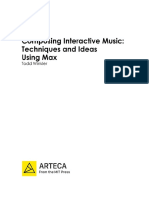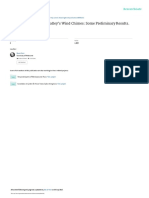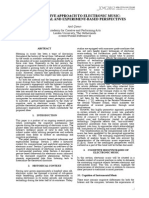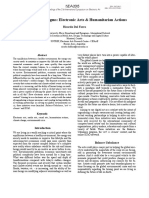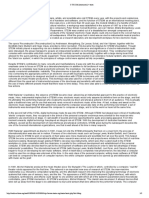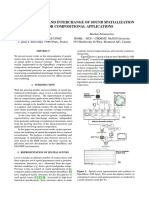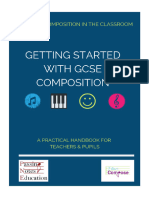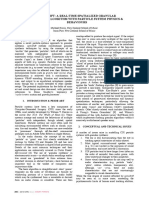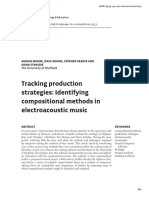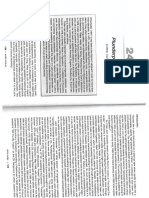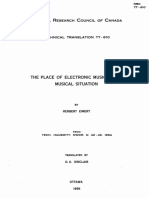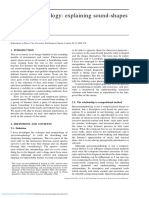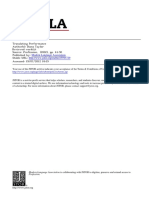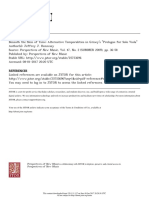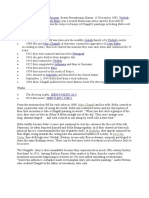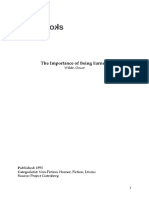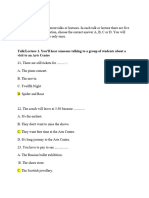Dance Sound
Uploaded by
agne.pupelyte07Dance Sound
Uploaded by
agne.pupelyte07VWB - Verlag für Wissenschaft und Bildung
The Corporeality of Sound and Movement in Performance
Author(s): Ako Mashino and Elina Seye
Source: The World of Music , 2020, new series, Vol. 9, No. 1, Choreomusicology I
Corporeality | Social Relations (2020), pp. 25-46
Published by: VWB - Verlag für Wissenschaft und Bildung
Stable URL: https://www.jstor.org/stable/10.2307/26970253
JSTOR is a not-for-profit service that helps scholars, researchers, and students discover, use, and build upon a wide
range of content in a trusted digital archive. We use information technology and tools to increase productivity and
facilitate new forms of scholarship. For more information about JSTOR, please contact support@jstor.org.
Your use of the JSTOR archive indicates your acceptance of the Terms & Conditions of Use, available at
https://about.jstor.org/terms
VWB - Verlag für Wissenschaft und Bildung is collaborating with JSTOR to digitize, preserve
and extend access to The World of Music
This content downloaded from
188.99.201.95 on Mon, 15 Mar 2021 14:55:33 UTC
All use subject to https://about.jstor.org/terms
the world of music 9 (2020) 1: 25–45
The Corporeality of Sound and Movement in
Performance
Ako Mashino and Elina Seye
Abstract
We create music and dance with the body and perceive both through it. The per-
former’s body is moulded by the practice of music and/or dance, transforming it into
a body with specific structure, competencies, and consciousness. The body of a per-
former is thus not any human body but a cultural body with particular physical skills
and a heightened awareness of corporeality. Furthermore, dance and music often oc-
cur simultaneously and can intertwine to the point of being inseparable. Even when
music occurs without dance, body movement is still involved in its performance, and
dancers may also produce sound. This article investigates the bodily basis of music
and dance as well as the significance of human corporeality in choreomusical inter-
relations. Drawing from interdisciplinary perspectives, it presents a cross-cultural
approach for choreomusical analysis that does not a priori divide music and dance
into two separate categories, but proceeds from the corporeal practices of music mak-
ing and dancing.
The corporeality of dance and music
Corporeality is currently a topic of ardent discussion in music and dance studies. Al-
though the significance of corporeality may seem self-evident because we create and
perceive music and dance with our body, the ways in which the human body guides
our perception and actions in the performing arts have not yet been fully explored.
Therefore, in this article and the two case studies that follow, we focus on the corpo-
reality of performance of music and dance, which we approach by analysing body
movement and its relations to sound.
Dance and music share a basic process of creation and perception: both are
generated by, and experienced as, movement. Movements can develop in different
ways—as sonic, visible, tactile, or kinesthetic phenomena—and can trigger and in-
teract with other forms of movement, corresponding to them, and at times converg-
This content downloaded from
188.99.201.95 on Mon, 15 Mar 2021 14:55:33 UTC
All use subject to https://about.jstor.org/terms
26 • the world of music (new series) 9 (2020) 1
ing or diverging from them. Dance is generally thought of as visible and tangible
bodily movement while music is considered primarily sonic, though, in reality, vis-
ible, kinetic, and sonic movements overlap. We will, therefore, take as the starting
point of our discussion that the human body and its movements are a significant
intersection of, and a shared basis for, dance and music. While we should consider
the distinctions each culture makes between different kinds of performative actions,
here we try to put aside the customary distinction between dance and music, instead
focusing on their corporeality and the body movements that produce both, in order
to establish a new perspective for choreomusical analysis.
Our experience of sound and body movements is grounded in the biological dis-
positions of human beings. Our visual and auditory cognition is directed by the sen-
sorimotor integration of cognitive systems, largely based on physical mechanisms
shared by all humans, while the interpretation of the meanings or values of such
bodily experiences are deeply embedded in their own cultural contexts. Although
such embodied aspects are crucial for both the perception and creation of performing
arts, here we use the term corporeality to discuss the bodily basis of performing arts
with an interdisciplinary approach, combining current findings in areas of empiri-
cal study such as neurobiology and psychology with ethnographic approaches (see
Clayton et al. 2013:1–16). We find that corporeality as a broader term is more useful
in this context than embodiment, which refers to “the process whereby collective
behaviors and beliefs, acquired through acculturation, are rendered individual and
‘lived’ at the level of the body” (Noland 2009:9).
This is not to imply that human corporeality can be separated from processes of
embodiment: the body of a dancer or a musician is always a “cultural body” (Thom-
as and Ahmed 2004) as well as a physical and biological body. Also Inger Damsholt
(2018:25) has duly criticised previous choreomusical research focusing on the body
for its narrow formalist and even essentialist approaches that largely ignore cultural
differences. In the words of Thomas Csordas (2002:58): “Body is not an object to
be studied in relation to culture, but is to be considered as the subject of the culture,
or in other words as the existential ground of culture.” We adopt the concept of the
“cultural body”—rather than embodiment as the process through which the cultural
body is “inscribed” into and/or expressed by the individual’s body (Ness 2008:12;
Ellingson 2017:2)—as another starting point for our discussion to avoid ethnocentric
assumptions about what constitutes dance and music.
The dancing body and the musicking body
Our corporeality is deeply rooted in the cultural, social, and historical contexts and
the ecological circumstances surrounding us, which continuously affect and direct
our body to make adjustments to them, while our body simultaneously actively af-
fects them (e.g., Shilling 1993:12, 70–99). This corporeality is plastic, and continu-
ously changing. The experiences of music and dance gradually transform bodies into
This content downloaded from
188.99.201.95 on Mon, 15 Mar 2021 14:55:33 UTC
All use subject to https://about.jstor.org/terms
Mashino & Seye. The Corporeality of Sound and Movement in Performance • 27
ones with specific structures, competencies, and consciousness, able to produce and
perceive music and dance, habituating (or embodying) particular cultural values and
aesthetics.
Susan Leigh Foster (1997) has written about “dancing bodies” and how they are
constructed through the practice and the experiences of dancing: “Each dance tech-
nique […] constructs a specialised and specific body […] that is unique in how it
looks and what it can do” (Foster 1997:241). She emphasises that a dancing body is
created through repetition, and that ideas about key areas of the body and their prop-
er relations are internalised through practice (ibid.). When learning to dance, one ac-
quires a body that can move in certain ways. Each culture and each dance tradition or
genre favours and entrains specific kinds of dancing bodies, which embody cultural
ideals of behavior through dance (see e.g. Bull 1997). In Javanese court tradition, for
example, acquiring a dancing body is associated with appropriate behavior, social
status and codes, and cultural identity, and thus dancing can be “a way of making a
world” (Hughes-Freeland 2008:20, 23, 77–110).
The body which is culturally attuned to music also has been discussed as a “mu-
sicking body” (Rahaim 2012:8) and an “acoustic body” (Yamada 2001:104). Yama-
da emphasises the significance of bodily competence in order to perceive and react
to the music (Yamada 2008:26–31), so dancers who dance in interaction with music,
therefore, should certainly have an acoustic body, or a musicking body. As Judy Van
Zile (1988:125, 132) powerfully insists, movement is so significant a part of the
music event that a musician might be considered as a dancer. We can presume that
musicians should also have a “dancing body” in three senses.
Firstly, musicians’ bodies are, in this way, more or less, “dancing,” moving with
the music they produce. Even the most modest background musicians, located at
the back of the stage, often move their bodies during performance, to say nothing
of Michael Jackson or the Korean Samulnori players, who are also skilled dancers.
Their movements are often regarded as an expression of their feeling and interpreta-
tion (Davidson and Malloch 2017 [2009]; Dahl et al. 2010:61; Moran 2013; Clayton
and Leante 2013).
Secondly, a musician’s body is a trained body, just like a dancer’s body, created
through the repetition of certain movements that correspond with certain sounds.
Through practice, the auditory image and the corresponding body motion become
increasingly tightly coupled in the experiences of musicians, as has been demon-
strated by empirical studies on cognition (see Keller 2008; Keller and Koch 2008;
Bangert et al. 2006). Jonathan De Souza (2017:9–10) points out that after Beethoven
lost his hearing, he would have perceived and composed music in terms of the “kin-
esthetic analogues” (De Souza 2017:9) coupling body movements and sonic compo-
nents, which were deeply inscribed in his body and mind through long-term experi-
ence as a musician. Such coupling can be acquired by anyone who accumulatively
practices and experiences the sound-movements correlations.
Thirdly, the musician’s body would also include the competence to perceive
and react to others’ dances. In order to effectively interact with dancers in a perfor-
This content downloaded from
188.99.201.95 on Mon, 15 Mar 2021 14:55:33 UTC
All use subject to https://about.jstor.org/terms
28 • the world of music (new series) 9 (2020) 1
mance, musicians should know how to incite dancers to move and negotiate with
them through the sound they create, even while their actual body movements might
appear minimal and are not interpreted as dance.
Just as the musician’s body is more or less a dancing body, the dancer’s body
may also be a musicking/acoustic body, which actively contributes to producing
sound either incidentally or as intentional self-accompaniment (see Kealiinohomoku
1965). The sounds of the shoes worn by tap dancers or the ringing tones of ghun-
groos tied to the feet of North Indian Kathak dancers definitely constitute a sig-
nificant part of the music as a whole, together with other musical instruments. Even
when they do not make audible sounds, dancers may directly or indirectly control
the music, to start, stop, increase or decrease the tempo, and so on, using cues struc-
tured as body movements, or through more subtle interactions. In such instances,
the dancers also actively “play music” through their body, much as a conductor’s
physical movements are not simply controlling the orchestra to generate the music
(Dineen 2011:146, 148; see also Luck 2011).
Performing arts emerge as a multi-sensory integration of body movements and
sound: aural, visual, tactile, kinesthetic, and osmatic information might pour into
us simultaneously, fully consuming our body and mind. Focusing on the body, we
can clearly understand the overlap, intertwined-ness and interaction of music- and
dance-making.
Studying dance as music or music as dance
Several ethnomusicologists have developed approaches that challenge prevailing
conceptions of music and dance. In particular those attempting to describe dance as
music, or music as dance, have provided perspectives that are relevant to our discus-
sion.
Gerhard Kubik (1972) described and analysed dance and music activities of the
boys’ initiation school (mukanda) in Eastern Angola, focusing on the body move-
ments. Based upon his transcription of sound-producing movements from silent
film, Kubik remarked that, even in the seemingly simple rhythms played with sticks
to accompany songs, there was “a difference between a listener’s auditory impres-
sion and a performer’s motor concept of sound patterns” (Kubik 1994:367), that
is, certain stick patterns would sound the same but would not be produced with the
same pattern of movements.1 Kubik also described a dance movement in which the
dancer’s skirt, made of tree bark fibres, produces a sound that local people imitate as
ka-cha-ka-cha-ka-cha. These kinds of mnemonics are used as teaching devices for
both music and dance during the mukanda (Kubik 1994:371–372).
Several other scholars have also discussed the body movements in instrumental
music. John Baily (1977), for example, analysed the musician’s body movement
and its interaction with the morphology of a dutār, an Afgan long-necked lute, and
Timothy Rice (1994) emphasised the significance of finger movements as a part of
This content downloaded from
188.99.201.95 on Mon, 15 Mar 2021 14:55:33 UTC
All use subject to https://about.jstor.org/terms
Mashino & Seye. The Corporeality of Sound and Movement in Performance • 29
the conceptual source that generates musical ideas in Bulgarian gaida bagpipe play-
ing.The approach to an instrument as a specific affordance for the musicians’ body
to create music has been further developed by De Souza (2017, chapters 3 and 4 in
particular) through the concept of “compositional instrument.”
It is noteworthy that these studies commonly describe an instrument as a space
and environment which allows the musicians’ body to explore the possible positions
and movements in order to create sound, and portray musical body movements as
resembling dance.2 For example, Bell Yung (1984) analyses the physical practices
of guqin (Chinese zither) playing, in particular hand movements, and proposes that
the player’s hands can be envisaged as two dancers, their movements as choreogra-
phy, and the musical instrument (the top board in this case) as a dance space (Yung
1984:508–510). All these approaches suggest that the music can be interpreted as
spatial movement, in addition to sonic movement, and that the instruments can be
the active interface affecting the process of creating the music as well as its structure.
As music performance might be seen as dance, dance might be heard as music.
Sylvia Nannyonga-Tamusuza (2015), in her analysis of Baganda baakisimba perfor-
mance, conducted an experiment adding devices that make sounds to several parts of
the dancers’ bodies, so that their movements were amplified to become audible. Her
analysis showed that the rhythms of the dancers’ body movements and those of the
drums and idiophones corresponded to, and interlocked with, each other, even if the
rhythms of the dancers could hardly be heard in ordinary performance.
Similarly, Elina Seye (2014:63–64, 71–74) analysed the dance-music interactions
in the Senegalese sabar dance events by notating the rhythm of the dancers’ feet—
which the drummers say they follow when playing but usually cannot be heard—and
combining these notations with notations of the musical patterns (sounds) played by
members of the sabar drum ensemble. The aim was to show how the dancer’s move-
ments relate to, and often also lead, the sounds of the ensemble of sabar drummers.
In contrast to Nannyonga-Tamusuza’s experiment, the movements in this study were
not “amplified” into sound, but their rhythmic form was transcribed with the help of
video footage.
Both music and dance evolve in space and time, revealing themselves as body
movement. It is tempting to say that music is partly dance, and dance is partly mu-
sic, or at least potentially can be such in many performance traditions whether the
“dancer” may or may not produce sound, and the body movements of the “musician”
may or may not be interpreted as dance. In any case, we cannot state with certainty
that music and dance are “similar but distinct phenomena” as Judith Lynne Hanna
(1982:68) does, but rather that they are overlapping and sometimes inseparably in-
terrelated. Therefore, we are suggesting an approach that avoids a priori categorisa-
tions by studying body movement and sound rather than music and dance.
This content downloaded from
188.99.201.95 on Mon, 15 Mar 2021 14:55:33 UTC
All use subject to https://about.jstor.org/terms
30 • the world of music (new series) 9 (2020) 1
Musical gestures and body movement
Recent empirical studies have discussed the significance of body movements in the
interaction between co-performers and between performer and audience, often with
a focus on “musical gestures” (see Godøy and Leman 2010; Gritten and King 2011;
Lesaffre et al. 2017). Laboratory experiments and computer analysis have provided
valuable insights especially regarding our biological and psychological dispositions,
whereas ethnographic research, by contrast, has shown how such musical gestures
play out in their cultural context (e.g. Qureshi 1990). These two approaches suc-
cessfully complement each other in recent ethnomusicological studies (see Clayton
2007, 2018; Rahaim 2012; and Pearson 2013, 2016).
Although musical gestures are sometimes discussed as more or less equivalent to
body movements, the word gesture usually denotes particular body movements with
specific meanings. For example, Rolf-Inge Godøy and Marc Leman (2010:5) define
gesture as “a movement of part of the body […] to express an idea or meaning”.3 In
some writings, however, this concept is used metaphorically. For example, Richard
Middleton (1990:201) defines musical gestures as “‘cognitive shapes’ (with affec-
tive and motor connections) which lie behind musical structures.” Middleton under-
stands them as sonic movements, such as a melodic motif or phrase, which imply a
kinetic process. Therefore, the listener easily receives and interprets these structures
of sound through their bodily experience.
While the studies on musical gestures offer an abundance of inspiring insights,
here we prefer the term “body movement” rather than gesture. The main reason is
that it is sometimes hard to discern whether or not a certain unit of movement during
a performance has a clearly defined meaning. Besides, meaning is culture-specific
and highly dependent upon the context. Therefore, body movement is the more in-
clusive term that enables us to consider all movements occurring in a performance,
but we may also refer to movements as gestures when appropriate. Furthermore,
body movement might not simply convey a meaning, as encoded into a gesture by
the performer and decoded by the perceiver; instead, the body itself—as a cultural,
musicking, and/or dancing body—is able to carry many layers of meanings.
Furthermore, bodily expertise and the kinaesthesia of the musicians can be in-
separably synthesised with instrument morphology, which can affect the musical
structure (Baily 1977:275, 1985), process of composing (De Souza 2017), and un-
derstanding of the musical theory (Tani 2017). In his comparison of dutār and rebāb,
Baily (1977:329) suggests that the motor patterns required for these instruments
respectively constitute the motor structure of the music specific to them. Tani Ma-
sato (2017:148) similarly claims that such kinesthetic positions, the movements of
fingers in particular, and the morphology of the musical instrument affords specific
understanding and playing techniques of the tetrachords, the basic units of Persian
classic music.
The body, having deeply habituated certain physical behaviours through train-
ing and experience, can lead the performer’s creativity. Paul Berliner (1994:152)
This content downloaded from
188.99.201.95 on Mon, 15 Mar 2021 14:55:33 UTC
All use subject to https://about.jstor.org/terms
Mashino & Seye. The Corporeality of Sound and Movement in Performance • 31
writes that in jazz, the “physical representation of the beat,” or the “dance” of the
musicians, “inspires soloists’ rhythmic conceptions, which in turn provides renewed
physical stimulus that finds immediate expression in improvisations.” As a cultural
body, the human body always assumes, and is able to transmit, more knowledge than
that which the person is able to know consciously, and with this embodied or “tacit”
knowledge (Polanyi 1966) the musicking and dancing bodies of trained performers
can indeed sometimes lead them to discoveries that they might not have reached
through conscious, analytical thinking. As dance scholar Carrie Noland (2009:7) has
stated: “If moving bodies perform in innovative ways, it is not because they manage
to move without acquired gestural routines but because they gain knowledge as a
result of performing them.”
Approaching music and dance as body movement
Building on the ideas presented above, we propose a new approach where we do not
a priori categorise certain kinds of body movements or movements of certain per-
formers as dance and other movements as mere tools for producing musical sounds,
but rather accept the simple fact that body movement is essential for both music and
dance. Music is, as Baily (1985:237) also writes, the sonic product of such move-
ments. We proceed here from Hanna’s (1992:318) statement that while body move-
ment is always necessary for producing music, music is not indispensable for dance,
although the body movements of a dancer may of course produce sound (see also
Hanna 1982). It thus seems reasonable to approach the interrelations of music and
dance with a focus on body movement as their common denominator.
Other scholars have similarly discussed the proximity, permeability, and com-
patibility of music and dance. For example, Jörgen Torp (2013), following the dis-
cussion of Marcello Sorce Keller (2012), writes that “music could be considered as
part of the overall terms of ‘rhythm’ and ‘movement,’” because “music and dance
share time in parallel when performed together” (Torp 2013:244). He also wonders
whether music can be adequately equated only to sound and suggests that movement
might be more appropriate (ibid.).
Sound consists of physical vibrations, meaning that it is essentially audible
movement. While movement generally refers to a change in position, which is relat-
ed to space, the process of movement is tied to time. Musical sounds are commonly
perceived as something that moves in space and time: the temporal process of subse-
quent sounds with different frequencies or durations is, for example, commonly per-
ceived as “musical movement,” and is often described with spatial metaphors, such
as “ascending” or “descending.” Sonic movements are often parallel to the body
movements which generate the sound in performing arts, but they are not necessarily
convergent; they can diverge maintaining some degree of autonomy. This is one rea-
son why we reserve the theoretical distinction between sound and body movements
This content downloaded from
188.99.201.95 on Mon, 15 Mar 2021 14:55:33 UTC
All use subject to https://about.jstor.org/terms
32 • the world of music (new series) 9 (2020) 1
for our analysis here, while the two might be perceived as inseparable or interpreted
as oneness in some cultures.
Furthermore, studies have shown that dance spectators are likely to experience
dance corporeally and not only visually (e.g., Parviainen 2003). Judging by the nu-
merous spatial and kinetic metaphors used to describe music, musical sounds are,
similarly, not only heard by ear but felt in one’s whole body. The perception of mu-
sic involves what Godøy (2011:71) calls motor-mimetic cognition: the listeners may
mentally simulate sound-producing body movements (see e.g. Frith 1996: 192; Tar-
vainen 2018). In certain contexts, dancing can be understood as an integral part of
listening to music (Frith 1996:142) or even as a way of hearing, in the sense of being
able to respond to music through appropriate movement. According to John Cher-
noff (1997:23–25), in the West African traditions he has studied, hearing the music
correctly requires feeling the beat of the music, although it may not be emphasised
acoustically, as well as being able to demonstrate it with movements. As participants
or spectators of a performance, then, we actually experience both music and dance
as a multi-sensory synthesis (see also Hanna 1992:319, 1982:64).
To emphasise the shared basis of music and dance, we will proceed with the con-
sideration of body movements, which include the movements of musicians and danc-
ers equally, thereby reconsidering the term “dance.” Such conceptual shift allows us
to consider body movements of musicians, ranging from choregraphed gesticulation
to unconscious and subtle movements, in conjunction with dance. Similarly, we need
to reconsider the validity of the term “music.” The most enduring and widely accept-
ed definition of music might be Blacking’s “humanly organised sound” (Blacking
1974), although recently some scholars have challenged its heavily human-centric
perspective (see Feld 2017; Brabec de Mori 2018; Sorce Keller 2012), and reexam-
ined the meaning and the arbiter of “organise” (Sakakeeny 2015:112).4 Although we
will concentrate here on sounds produced by humans, we will use the term sound
as a more encompassing term, because sounds which may interact with body move-
ments are not limited to those intentionally organized as music, which is defined
differently in each culture.
The consideration of sound and body movement instead of music and dance will
enable us to present a new approach for analysing the relevant interactions within
a performance without drawing boundaries between music and dance or different
kinds of body movements before interpreting their role and significance within the
performance being analysed.
A new framework for examining interactions of sound and body movements
Movements, both sonic and kinesthetic, can dynamically generate and trigger other
movements in a performance, whether in a single person or among multiple partici-
pants. Some of the movements make an audible sound, while others do not. Both
body movements and the audible sounds produced may trigger other body move-
This content downloaded from
188.99.201.95 on Mon, 15 Mar 2021 14:55:33 UTC
All use subject to https://about.jstor.org/terms
Mashino & Seye. The Corporeality of Sound and Movement in Performance • 33
ments, which then have their own effects and so forth. Thus, body movements and
sound connect within a performance in multiple ways, circulating among multiple
bodies, as if mutually converting and reinforcing creative energy.
Ethnomusicologists, ethnochoreologists and anthropologists have struggled
to clarify the complicated interactions between multi-sensory elements in perfor-
mances. For example, in the study of ritual performances in Cuba and West Africa,
Amanda Villepastour (2018:270–272) suggested a pentagonal diagram, in which
spoken word, vocal music, instrumental music, dance and gesture are located at the
vertices, reworking a framework proposed by V. Kofi Agawu (2016:162). The dia-
gram by Villepastour includes three continua, with binary components (isolated/full-
body, semantic/non-semantic, and silent/sounded). The diagram represents a holistic
view of sound-body relationships and suggests that all of these components connect
to each other to support the participants in becoming orisha, holy spirits, during a
ritual. While Villepastour’s diagram is also likely to be a useful tool for analysing
performances in other contexts, we propose a similarly encompassing but simpler
framework to categorise the sound-body movement interactions for cross-cultural
examination.
We suggest five possible relations between sound and body movements in a per-
formance:
(a) the sound and body movement intertwined in a single performer;
(b) the sound of a performer and the sound of others;
(c) the sound of a performer and the body movement of others;
(d) the body movement of a performer and the sound of others;
(e) the body movement of a performer and the movement of others.
Here, these relations are interpreted from the perspective of a single performer,
while the “others” may be anyone present. Also, the term “performer” is used in a
broad sense and can denote any of the actors involved in the process of creating a
performance, including musicians, dancers, and audience members. “Sound” refers
here to anything audible, not only to sounds that might be categorised as music. Al-
though sounds are produced by body movement, some performers may concentrate
only on the sound, not on the body movements through which it is generated.
Below, we briefly describe these five possible relations, with reference to the
authors’ own research examples of Senegalese sabar music and dance and the Bali-
nese instrumental music, gender wayang, which will be discussed in detail in later
chapters.
(a) the sound and body movement intertwined in a single performer: Both sabar
drummers and gender wayang musicians must of course move their hands and arms
to strike their instruments to produce sound. However, it is not uncommon for sabar
drum ensembles to play show pieces that include a preplanned choreography, such
as the musicians walking in a line while playing or adding hand movements that do
not produce sound, and gender wayang musicians may also consciously display the
choreographed movements in performance for competition.
This content downloaded from
188.99.201.95 on Mon, 15 Mar 2021 14:55:33 UTC
All use subject to https://about.jstor.org/terms
34 • the world of music (new series) 9 (2020) 1
(b) the sound of a performer and the sound of others: In both gender wayang
and the sabar, the musicians naturally listen to the sound of each other to create
their own sound. The leader of the ensemble also supplies musical cues when, for
example, switching to another rhythm, and expects specific patterns of sound as the
response.
(c) the sound of a performer and the body movement of others, and
(d) the body movement of a performer and the sound of others: For the audience,
(c) and (d) might be experienced as a synthesis, but for the performers they are ex-
perienced as different types of interaction. In shadow puppetry called wayang kulit,
which gender wayang accompanies, the puppeteer’s voice, the sound of cempala
(a short wooden stick held in the hands or toes), and the movements of the puppets
lead the whole performance, whereas the musicians basically follow the puppeteer.
But at certain points, the puppeteer also follows the music, in order to precisely fit
the puppets’ movements to sound. In sabar, the sounds of a rhythmic cue played by
a lead drummer can trigger the body movements of other musicians to produce cer-
tain sounds, and the dancer expects a sonic response from the lead drummer to her
movements.
(e) the body movement of a performer and the movement of others: In sabar,
dancing typically occurs as short solos, but it is also quite common that two or more
people dance simultaneously, either by accident, without paying much attention to
the others dancing at the same time, or sometimes intentionally. In the latter case,
the people dancing together usually try to mirror each other’s movements. In gender
wayang competition, where the music is performed as purely instrumental without
puppetry, the musicians often perform with a prepared choreography, before the first
stroke and between phrases. They sometimes organize their body movements physi-
cally even without creating sound.
As can be seen in our examples, certain modes of interrelations may be more
characteristic to specific performance traditions. In the sabar, one can see that the re-
lations between the body movements of the dancers and the sounds produced by the
drummers (modes c and d) are indeed central. The sabar thus largely corresponds to
the widespread idea that the body movements of musicians are only of instrumental
value, as the means for producing sound. However, one can also similarly claim that
the sabar dancers’ ultimate aim is to produce sound, to trigger a specific audible re-
sponse from the lead drummer, although their body movements are likely to serve
other purposes as well.
In the case of gender wayang, all of these interactions—between sound and body
movement, and between a performer and other performers or the audience—may
occur in a performance at different levels and with different significance according
to the context, such as puppetry, rituals, competitions, or lessons. While beginners
who are eager to grasp what their teacher is doing, may be more focussed on the
body movements of their teachers, experienced performers may only peripherally
perceive their co-performers’ body movement. Hence these models can help analy
This content downloaded from
188.99.201.95 on Mon, 15 Mar 2021 14:55:33 UTC
All use subject to https://about.jstor.org/terms
Mashino & Seye. The Corporeality of Sound and Movement in Performance • 35
sing various modes of interaction between multiple agents, which co-occur in com-
plicated ways in a single performance.
While we have emphasised the synthesis of sound and body movements, it should
be remembered that they are not always convergent, even when they co-occur in per-
formance. Paul Mason (2017) cited the case of silek minang, a traditional fighting art
or combat-dancing in West Sumatra, where the silek practitioner tries to be as free as
possible from the influence of the music, so as not to step with the rhythm, lest their
movements become predictable and they can be easily attacked by an adversary,
though the music will still have potential effects on the performer’s mindset and the
perception of the audience (Mason 2017:225).
Ako Mashino (2014) recounts that in Balinese arja, a musical theater, the per-
formers’ attention toward the other performers frequently changes over the course of
the performance. At the moment when the actor/actress sings a free-rhythm melody,
she/he appears unconcerned about the details of the music, because neither song nor
dance necessarily fully converges with the music. But after only a moment, near
the end of the phrase, the actor/actress becomes highly attentive in listening to the
music, to catch the right timing to end their movement pattern at precisely the same
time as the end of the gong cycle. The musicians, on the other hand, are presumed
to maintain their attention on the actor/actress throughout the performance, whilst
they most attentively watch the actors’ specific foot movements to tune into their
timing (Mashino 2014:102–105). Even in a single performance, an abundance of
sounds and body movements are created, which sometimes converge and sometimes
diverge, intentionally or not, and with varying degrees of consistency.
In collaborative performance, the performers in their various roles, as well as the
audience members, may have different perspectives on the interaction taking place,
reflecting the roles and actions they assume. The co-existence of different views,
however, does not preclude them from sharing in a performance and contributing
to the process of generating it. Consequently, it depends on the decision of the re-
searcher as to the kinds of interactions they choose to focus on in their analysis or if
they try to cover all modes of interaction within the performance under study.
Complex interactions
To examine how the complex network of these interactions play out in a performance
and describe the dynamics generated between the participants, we can strengthen our
categorisation by applying three categories proposed by Martin Clayton (2013:30)
for discussing musical entrainment in performance: intra-individual, inter-individual
(or intra-group) and inter-group. Although Clayton considers “inter-individual” and
“intra-group” as synonymous, we feel that they can be different, especially from the
performers’ point of view. We will thus separate them, to demonstrate the multiplic-
ity of possible relations within a performance.
This content downloaded from
188.99.201.95 on Mon, 15 Mar 2021 14:55:33 UTC
All use subject to https://about.jstor.org/terms
36 • the world of music (new series) 9 (2020) 1
Figs. 1, 2, 3, and 4 visualise the possible interactions between sound and body
movements which we have listed above as (a) to (e), integrated with the intra-indi-
vidual, inter-individual, intra-group, and inter-group categorisation. Each circle in
the figure represents a person. Besides the musicians and dancers, the audience may
also participate in these interactions, by reacting to the performance with applause,
booing, shouting, or moving their own bodies. The arrows in the figure indicate pos-
sible interactive directions, but not all of them necessarily occur equally in practice.
Fig. 1 visualises intra-individual interaction of an individual’s own sound and body
movements, which corresponds to mode (a) in our categorisation.
Fig. 1: Image of intra-personal sound-body movement interaction.
Fig. 2 is the case of inter-individual interaction, where there are two partici-
pants in the performance. Any type of the sound-body movement relations we have
listed can occur in the process, as the performers constantly interact with each other
through sounds and various kinds of movements.
Fig. 2: Image of possible inter-individual sound-body movement interaction.
This content downloaded from
188.99.201.95 on Mon, 15 Mar 2021 14:55:33 UTC
All use subject to https://about.jstor.org/terms
Mashino & Seye. The Corporeality of Sound and Movement in Performance • 37
Fig. 3: Image of possible intra-group sound-body movement interaction.
In an ensemble, musicians naturally constitute a more complex interactive net-
work, hearing, seeing the others and moving themselves as depicted in intra-group
interaction in fig. 3. Each performer pays different attention to the various elements
of other participants’ movements at each moment of the performance: The drummer
might attentively watch the dancer’s body, for example, while the other musician is
concentrating exclusively on the beat of the drummer and the dancer might pay at-
tention to the audience reactions rather than their co-performers.
Some participants might form smaller interactive networks within a perfor-
mance: for example, a group of musicians can establish a cohesive musical network,
which reacts as a whole to the coordinated body movements of a group of dancers
(inter-group interaction, see fig. 4).
These diagrams offer a starting point from which to overview and explore in
detail the possible interactions between various agents and various elements. Each
performance formulates its own interactive network, depending upon the genre and
context, which naturally can transform even from moment to moment in a single
performance.
This content downloaded from
188.99.201.95 on Mon, 15 Mar 2021 14:55:33 UTC
All use subject to https://about.jstor.org/terms
38 • the world of music (new series) 9 (2020) 1
Fig. 4: Image of possible inter-group sound-body movement interaction.
To explore these interactive circulations that create a performance, we may ask
multiple questions: How do the sound and body movements circulate inside individ-
uals and within a smaller or a larger group? How is each loop bound to other loops?
Are they as a whole highly organised or not? How does the individual or a group
experience and interpret the emerging dynamics? Besides examining these varied
modes of interactions emerging within a performance, we should also explore the
overall dynamics between performers, the ways in which a performance is shaped
through interactions, and how they are embedded in, and recreate, the social context.
In a performance, each one of these interactions simultaneously creates and ex-
changes aural, visual, and kinaesthetic movements with one another and contributes
to the dynamic circulation as a whole, reflecting and reproducing a particular cul-
tural concept of gender duality, desire, and power. Thus, the sound and body move-
ment interaction in a performance has manifold dimensions as a constellation of
such circles as depicted in the figures above. The process of interactions should also
be examined in their social and cultural context to understand which interactions are
This content downloaded from
188.99.201.95 on Mon, 15 Mar 2021 14:55:33 UTC
All use subject to https://about.jstor.org/terms
Mashino & Seye. The Corporeality of Sound and Movement in Performance • 39
culturally significant within a performance and to interpret their meanings. For ex-
ample, Henry Spiller (2010:143–209) describes the West Javanese dance-music cul-
ture as an “erotic triangle,” in which the ronggeng (female professional dancer) as an
object of desire for men, together with the powerful drum sound (created by a male
professional musician), offer a dancer (amateur male) a liberating, and at the same
time regulating, power to dance. The circulation of sound and body movements in
performance thus reflects and also creates social and cultural dynamics.
From interactions to inter-corporeality
While all sound and body movement components could potentially interact with oth-
ers, some elements can be more tightly intertwined to shape a powerful circular loop
serving distinctive functions to elicit specific types of reactions. One can also find
highly systematised organisations incorporating performers with distinct roles, com-
petencies, and knowledge, that all contribute in activating the interactive networks
which comprise the roles assumed by performers and the relationships or links be-
tween them (Brinner 1995:169). Further, as Kendra Stepputat (2017) discusses, the
relation between sound and bodily movement can have a wide variety of intensity,
leadership, and levels of improvisation. Therefore, we need to carefully consider the
culture-specific and context-dependent aspects of the interrelations between sound
and body movements. The categorisations we have developed in this article are rela-
tively simple tools for analysing complex performances, but in our experience they
can be helpful for identifying the often minute details of choreomusical interactions.
In a performance created through interactions among multiple participants, per-
formers must acquire a heightened sense of the actions of others in order to respond
immediately. For example, Julian Gerstin (1998:141–142) describes the concept of
réciprocité, in Martiniquan bèlè, a process in which the drummers and dancers re-
spond quickly to subtle cues. The ultimate in réciprocité is “when dancers and drum-
mers tune into one another so well that no cue is needed,” and the drummers simply
know what the dancers will do in the next moment from their experience and knowl-
edge. Made Mantle Hood (2017:51) proposes that similar things can occur among
Balinese dancers and drummers, who feel an “‘unrestricted potentiality’ that frees
both to makebar (take flight) together.” Such complicated and deeply incorporated
interactions with others can bring the performers to an inter-subjective, or more ac-
curately, inter-corporeal milieu, in which the dancer moves the musician’s body and
the sound moves the dancer’s body. The embodiment of the cultural, musicking and
dancing bodies form the basis of such inter-corporeal interactions, but we claim that
the training and repetition also develops the performers’ corporeal consciousness,
something that Csordas (2002:244–246) has called somatic modes of attention, that
is, “culturally elaborated ways of attending to and with one’s body,” a heightened
sensitivity to one’s own as well as other people’s corporeality.
This content downloaded from
188.99.201.95 on Mon, 15 Mar 2021 14:55:33 UTC
All use subject to https://about.jstor.org/terms
40 • the world of music (new series) 9 (2020) 1
In the interactive complex, performers often simultaneously perceive and create
sound or movements in multiple ways, responding to previous sounds and move-
ments with their own, and are thereby involved in a vortex of recurring interactions
between self and others. These interactions also persuade the audience to be in-
volved in the highly inter-subjective milieu of a performance. Such an inter-corpo-
real experience involving multi-sensory interactions and a sense of connection with
others, sometimes to the point of sensing as if being part of the same body, might be
the driving force behind participation and creation in any performing art.
Notes
1 Although Kubik does not give an explanation for this difference, we assume that the different
body movements that produce the “same” musical pattern are actually likely to produce slightly
different accentuation or micro-timing in sound, and therefore one cannot arbitrarily choose
which movement pattern to use.
2 David Sudnow (1978), for example, also describes the improvisation of jazz pianists primarily
in terms of kinaesthesia of the hands and fingers on the keyboard.
3 Jensenius et al. (2010:19) also define musical gesture as “an action pattern that produces music,
is encoded in music, or is made in response to music,” which they relate to movement, defined
as “the changing of a physical position of a body part or an object, which can be objectively
measured.”
4 Steven Feld (2017:8) also proposes the concept of acoustemology as an alternative to ethnomu-
sicology, adding post-human and post-humanist perspectives.
References
Agawu, Kofi
2016 The African Imagination in Music. New York: Oxford University Press.
Baily, John
1977 “Movement Patterns in Playing the Herati Dutār.” In The Anthropology of the Body.
John Blacking, ed. London: Academic Press, 275–350.
1985 “Music Structure and Human Movement.” In Musical Structure and Cognition. Peter
Howell, Ian Cross and Robert West, eds. London: Academic Press, 237–258.
Bangert, Marc, Thomas Peschel, Gottfried Schlaug, Michael Rotte, Dieter Drescher, Hermann Hin-
richs, Hans-Jochen Heinze and Eckart Altenmüller
2006 “Shared Networks for Auditory and Motor Processing in Professional Pianists: Evi-
dence from fMRI Conjunction.” Neuro Image 30:917–926.
Berliner, Paul
1994 Thinking in Jazz: The Infinite Art of Improvisation. Chicago: The University of Chi-
cago Press.
Blacking, John
1974 How Musical is Man? Seattle: University of Washington Press.
This content downloaded from
188.99.201.95 on Mon, 15 Mar 2021 14:55:33 UTC
All use subject to https://about.jstor.org/terms
Mashino & Seye. The Corporeality of Sound and Movement in Performance • 41
Brabec de Mori, Bernd
2018 “Music and Non-Human Agency.” In Ethnomusicology: A Contemporary Reader,
Vol.2. Jennifer C. Post, ed. New York: Routledge,181–194.
Brinner, Benjamin
1995 Knowing Music, Making Music: Javanese Gamelan and the Theory of Musical Com-
petence and Interaction. Chicago: University of Chicago Press.
Bull, Cynthia Jean Cohen
1997 “Sense, Meaning, and Perception in Three Dance Cultures.” In Meaning in Motion.
New Cultural Studies of Dance. Jane C. Desmond, ed. Durham and London: Duke
University Press, 269–287.
Chernoff, John
1997 “‘Hearing’ in West African Idioms.” The World of Music 39(2):19–25.
Clayton, Martin
2007 “Time, Gesture and Attention in a Khyāl Performance.” Asian Music 38(2):71–96.
2013 “Entrainment, Ethnography and Musical Interaction.” In Experience and Meaning in
Music Performance. Martin Clayton, Byron Deck and Laura Leante, eds. New York:
Oxford University Press, 17–39.
2018 “Time, Gesture, and Attention in a Khyāl Performance” In Ethnomusicology: A Con-
temporary Reader, vol. 2. Jennifer C. Post, ed. vol.2, New York: Routledge, 249–266.
Clayton, Martin, Byron Dueck and Laura Leante
2013 “Introduction; Experience and Meaning in Music Performance.” In Experience and
Meaning in Music Performance. Martin Clayton, Byron Dueck and Laura Leante, eds.
New York: Oxford University Press, 1–16.
Clayton, Martin and Laura Leante
2013 “Embodiment in Music Performance.” In Experience and Meaning in Music Perfor-
mance. Martin Clayton, Byron Dueck and Laura Leante, eds. New York: Oxford Uni-
versity Press, 188–207.
Csordas, Thomas J.
2002 Body/Meaning/Healing. New York: Palgrave Macmillan.
Dahl, Sofia, Frédéric Bevilacqua, Roberto Bresin, Martin Clayton, Laura Leante, Isabella Poggi,
and Nicolos Rasamimanana
2010 “Musical Gestures: Concepts and Methods in Research” In Musical Gestures: Sound,
Movement, and Meaning. Rolf Inge Godøy and Marc Leman, eds. New York: Rout-
ledge, 36–68.
Damsholt, Inger
2018 “Identifying Choreomusical Research.” In Music-Dance: Sound and Motion in Con-
temporary Discourse. Veroli, Patrizia, and Gianfranco Vinay, eds. New York: Rout-
ledge, 19–34.
Davidson, Jane and Stephen Malloch
2017 [2009] “Ongakutekina komyunikeishon: ensouni okeru shintai no ugoki.” [in Japanese;
Musical communication: the body movements of performance] In Kizuna no Ongaku-
sei: Tsunagari no kiban wo motomete [Communicative Musicality: Exploring the Basis
of Human Companionship] Stephen Malloch and Colwyn Trevarthen, eds. Translated
by Kouichi Negayama et al. Tokyo: Ongaku no tomo sha, 547–565.
De Souza, Jonathan
2017 Music at Hand: Instruments, Bodies, and Cognition. New York: Oxford University
Press.
This content downloaded from
188.99.201.95 on Mon, 15 Mar 2021 14:55:33 UTC
All use subject to https://about.jstor.org/terms
42 • the world of music (new series) 9 (2020) 1
Dineen, Philip Murray
2011 “Gestural Economies in Conducting.” In New Perspectives on Music and Gesture.
Anthony Gritten and Elaine King, eds. Farnham: Ashgate, 131–157.
Ellingson, Laura L.
2017 Embodiment in Qualitative Research. New York and London: Routledge.
Feld, Steven
2017 “On Post-Ethnomusicology Alternatives: Acoustemology.” In Ethnomusicology or
Transcultural Musicology? Francesco Giannattasio and Giovanni Guiriati, eds. Udine:
Nota, 82–98.
Foster, Susan Leigh
1997 “Dancing Bodies.” In Meaning in Motion. New Cultural Studies of Dance. Jane C.
Desmond, ed. Durham and London: Duke University Press, 235–257.
Frith, Simon
1996 Performing Rites. On the Value of Popular Music. Cambridge: Harvard University
Press.
Gerstin, Julian
1998 “Interaction and Improvisation between Dancers and Drummers in Martinican Bèlè.”
Black Music Research Journal 18(1/2): 121–165.
Godøy, Rolf Inge
2011 “Coarticulated Gestural-Sonorous Objects in Music.” In New Perspectives on Music
and Gesture. Anthony Gritten and Elaine King, eds. Farnham: Ashgate, 67–82.
Godøy, Rolf Inge and Marc Leman (eds.)
2010 Musical Gestures: Sound, Movement, and Meaning. New York: Routledge.
Gritten, Anthony and Elaine King (eds.)
2011 New Perspectives on Music and Gesture. Farnham: Ashgate.
Hanna, Judith Lynne
1982 “Is Dance Music? Resemblances and Relationships.” The World of Music 24(1):57–71.
1992 “Dance.” Ethnomusicology. An Introduction. Helen Myers, ed. London: Macmillan,
315–326.
Hood, Made Mantle
2017 “Persistent Mutualisms: Energizing the Symbiotic Relationship between Balinese
Dancer and Drummer.” In Sounding the Dance, Moving the Music: Choreomusico-
logical Perspectives on Maritime Southeast Asian Performing Arts. Mohd Anis Md
Nor and Kendra Stepputat, eds. London and New York: Routledge, 42–56.
Hughes-Freeland, Felicia
2008 Embodied Communities: Dance Traditions and Change in Java. New York: Berghahn
Books.
Jensenius, Alexander Refsum, Marcelo M. Wanderley, Rolf Inge Godøy and Marc Leman
2010 “Musical gestures: Concepts and methods in research.” In Musical Gestures: Sound,
Movement, and Meaning. Rolf Inge Godøy and Marc Leman, eds. New York: Rout-
ledge, 12–35.
Kealiinohomoku, Joann W.
1965 “Dance and Self-Accompaniment.” Ethnomusicology 9(3):292–295.
This content downloaded from
188.99.201.95 on Mon, 15 Mar 2021 14:55:33 UTC
All use subject to https://about.jstor.org/terms
Mashino & Seye. The Corporeality of Sound and Movement in Performance • 43
Keller, Peter E.
2008 “Joint Action in Music Performance.” In Enacting Intersubjectivity: A Cognitive and
Social Perspective on the Study of Interactions. Francesca Morganti, Antonella Caras-
sa and Giuseppe Riva, eds. Amsterdam: IOS Press, 205–221.
Keller, Peter and Iring Koch
2008 “Action Planning in Sequential Skills.” The Quarterly Journal of Experimental Psy-
chology 61(2):275–291.
Kubik, Gerhard
1972 “Transcription of African Music from Silent Film: Theory and Methods.” African Mu-
sic 5(2):28–39.
1994 Theory of African Music. Volume I. Chicago and London: The University of Chicago
Press.
Lesaffre, Micheline, Pieter-Kan Maes and Marc Leman (eds.)
2017 The Routledge Companion to Embodied Music Interaction. New York: Routledge.
Luck, Geoff
2011 “Computational Analysis of Conductors’ Temporal Gestures” In New Perspectives on
Music and Gesture. Anthony Gritten and Elaine King, eds. Farnham: Ashgate, 159–
175.
Mashino Ako
2014 “The Body as Interaction: Interaction and Collaboration of Voice, Body and Music
in Balinese Arja.” In Sounding the Dance, Moving the Music: Choreomusicological
Perspectives on Maritime Southeast Asian Performing Arts. Mohd Anis Md Nor and
Kendra Stepputat, eds. London and New York: Routledge, 96–107.
Mason, Paul
2017 “Combat-Dancing, Cultural Transmission, and Choreomusicology. The Globalization
of Embodied Repertoires of Sound and Movement.” In The Routledge Companion to
Embodied Music Interaction. Micheline Lesaffre, Pieter-Jan Maes and Marc Leman,
eds. New York: Routledge, 223–231.
Middleton, Richard
1990 Studying Popular Music. Milton Keynes & Philadelphia: Open University Press.
Moran, Nikki
2013 “Social Co-Regulation and Communication in North Indian Duo Performance.” In Ex-
perience and Meaning in Music Performance. Martin Clayton, Byron Deck and Laura
Leante, eds. New York: Oxford University Press, 40–61.
Nannyonga-Tamusuza, Sylvia
2015 “Music as Dance and Dance as Music: Interdependence and Dialogue in Baganda
Baakisimba Performance.” Yearbook for Traditional Music 47:82–96.
Ness, Sally Ann
2008 ”The Inscription of Gesture: Inward Migrations in Dance.” In Migrations of Ges-
ture. Carrie Noland and Sally Ann Ness, eds. Minneapolis: University of Minnesota
Press, 1–30.
Noland, Carrie
2009 Agency and Embodiment: Performing Gestures/Producing Culture. Cambridge: Har-
vard University Press.
Parviainen, Jaana
2003 “Kinaesthetic Empathy.” Dialogue and Universalism 11–12:151–162.
This content downloaded from
188.99.201.95 on Mon, 15 Mar 2021 14:55:33 UTC
All use subject to https://about.jstor.org/terms
44 • the world of music (new series) 9 (2020) 1
Pearson, Lara
2013 “Gesture and The Sonic Event in Karanatak Music.” Empiricial Musicology Review
8(1):2–14.
2016 “Coarticulation and Gesture: An Analysis of Melodic Movement in South Indian Raga
Performance.” Music Analysis 35(3):280–313.
Polanyi, Michael
1966 The Tacit Dimension. New York: Doubleday & Company.
Qureshi, Regula Burckhardt
1990 “Musical Gesture and Extra-Musical Meaning: Words and Music in the Urdu Ghazal.”
Journal of the American Musicological Society 43(3):457–497.
Rahaim, Matthew
2012 Musicking Bodies: Gesture and Voice in Hindustani Music. Middletown: Wesleyan
University Press.
Rice, Timothy
1994 May It Fill Your Soul: Experiencing Bulgarian Music. Chicago: The University of Chi-
cago Press.
Sakakeeny, Matt
2015 “Music.” In Keywords in Sound. David Novak and Matt Sakakeeny, eds. Durham:
Duke University Press, 112–124.
Seye, Elina
2014 Performing a Tradition in Music and Dance. Embodiment and Interaction in Sabar
Dance Events. Helsinki: Global Music Centre.
Shilling, Chris
1993 The Body and Social Theory. Newbury Park: Sage Publications.
Sorce Keller, Marcello
2012 “Zoomusicology and Ethnomusicology: A Marriage to Celebrate in Heaven.” Year-
book for Traditional Music 44:166–183.
Spiller, Henry
2010 Erotic Triangles: Sundanese Dance and Masculinity in West Java. London and Chi-
cago: University of Chicago Press.
Stepputat, Kendra
2017 “The Balinese Kecak: An Exemplification of Sonic and Visual (Inter) Relations.”
Sounding the Dance, Moving the Music: Choreomusicological Perspectives on Mari-
time Southeast Asian Performing Arts. Mohd Anis Md Nor and Kendra Stepputat, eds.
London and New York: Routledge, 31–41.
Sudnow, David
1978 Ways of the Hand: The Organization or Improvised Conduct. Cambridge, MA: Har-
vard University Press.
Tani Masato
2017 “Yubi de Kanji Rikai Suru Koto: Gakkikande Kotonaru Shintaikankaku no Kenkyu ni
mukete [In Japanese: Sensing and Understanding from Fingers: Toward Comparative
Studies of Different Physical Senses among Various Instrument Players].” Iran Kenkyu
13:136–149.
This content downloaded from
188.99.201.95 on Mon, 15 Mar 2021 14:55:33 UTC
All use subject to https://about.jstor.org/terms
Mashino & Seye. The Corporeality of Sound and Movement in Performance • 45
Tarvainen, Anne
2018 “Singing, Listening, Proprioceiving: Some Reflections on Vocal Somaesthetics.” As-
thetic Experience and Somaesthetics. Richard Shusterman, ed. Leiden and Boston:
Brill, 120–142.
Thomas, Helen and Ahmed Jamilah (eds.)
2004 Cultural Bodies. Ethnography and Theory. Malden/Oxford/Carlton: Blackwell Pub-
lishing.
Torp, Jörgen
2013 “Musical Movement: Towards a Common Term for Music and Dance.” Yearbook for
Traditional Music 45:231–249.
Van Zile, Judy
1988 “Examining Movement in the Context of the Music Event: A Working Model.” Year-
book for Traditional Music 20:125–133.
Villepastour, Amanda
2018 “Speaking with the Body in Nigerian and Cuban Orisha Music: Musical Movements
in Song, Dance, and Trance.” In Ethnomusicology: A Contemporary Reader. Vol. 2.
Jennifer C. Post, ed. New York: Routledge, 267–288.
Yamada, Yoichi
2001 “Acoustic Body: Voice Resounding through the Waxei People, Papua New Guinea.” In
Traditionalism and Modernity in the Music and Dance of Oceania: Essays in Honour
of Barbara B. Smith. Helen Reeves Lawrence and Don Niles, eds. Sydney: University
of Sydney, 103–112.
Yamada, Yoichi (ed.)
2008 Ongaku suru Shintai [in Japanese] Kyoto: Showa-do.
Yung, Bell
1984 “Choreographic and Kinesthetic Elements in Performance on the Chinese Seven-
String Zither.” Ethnomusicology 28(3):505–517.
This content downloaded from
188.99.201.95 on Mon, 15 Mar 2021 14:55:33 UTC
All use subject to https://about.jstor.org/terms
This content downloaded from
188.99.201.95 on Mon, 15 Mar 2021 14:55:33 UTC
All use subject to https://about.jstor.org/terms
You might also like
- An Analysis of Denis Smalley's Wind ChimesNo ratings yetAn Analysis of Denis Smalley's Wind Chimes8 pages
- The Music of The Environment: For Making Mu Performances Orga A NNo ratings yetThe Music of The Environment: For Making Mu Performances Orga A N6 pages
- Foss ChangingComposerPerformerRelationship 1963No ratings yetFoss ChangingComposerPerformerRelationship 196310 pages
- Cognitive Approach To Electronic Music TheoreticalNo ratings yetCognitive Approach To Electronic Music Theoretical4 pages
- Breaking Paradigms: Electronic Arts & Humanitarian Actions: Ricardo Dal FarraNo ratings yetBreaking Paradigms: Electronic Arts & Humanitarian Actions: Ricardo Dal Farra8 pages
- Haptics in Computer Music: A Paradigm ShiftNo ratings yetHaptics in Computer Music: A Paradigm Shift4 pages
- An Interview With Sensorband: Bert BongersNo ratings yetAn Interview With Sensorband: Bert Bongers12 pages
- Artificial Perception and Music Recognition - Tanguiane, Andranick SNo ratings yetArtificial Perception and Music Recognition - Tanguiane, Andranick S223 pages
- From Classicism To Modernism The EvolutionNo ratings yetFrom Classicism To Modernism The Evolution17 pages
- 21 Sciarrino-Monducci 2021 The Listening SpaceNo ratings yet21 Sciarrino-Monducci 2021 The Listening Space98 pages
- Berio's Sequenzas: Essays On Performance, Composition and Analysis by Janet K Halfyard100% (1)Berio's Sequenzas: Essays On Performance, Composition and Analysis by Janet K Halfyard12 pages
- Aleatoric Music: Aleatoric Music (Also Aleatory Music or Chance Music From The Latin Word AleaNo ratings yetAleatoric Music: Aleatoric Music (Also Aleatory Music or Chance Music From The Latin Word Alea6 pages
- Ópera Multimídia.: "I Use Tecnology in Order To Hate It More Properly. I Make Technology Look Ridiculous" Nam Jun PaikNo ratings yetÓpera Multimídia.: "I Use Tecnology in Order To Hate It More Properly. I Make Technology Look Ridiculous" Nam Jun Paik4 pages
- Xsens Performance: Playing Music by The Rules100% (1)Xsens Performance: Playing Music by The Rules2 pages
- Spin Drift A Real Time Spatialized Granular SynthesisNo ratings yetSpin Drift A Real Time Spatialized Granular Synthesis4 pages
- 6 - Performing Electroacoustic Music A Wider View of InteractivityNo ratings yet6 - Performing Electroacoustic Music A Wider View of Interactivity9 pages
- Creativity in The Recording Studio: Alternative Takes Paul Thompson Available Full Chapters100% (3)Creativity in The Recording Studio: Alternative Takes Paul Thompson Available Full Chapters78 pages
- Learning EDMThe Schoolingof Electronic Dance Musicians 2022No ratings yetLearning EDMThe Schoolingof Electronic Dance Musicians 202285 pages
- The Aesthetics of Interactive Music Systems: Robert Rowe0% (1)The Aesthetics of Interactive Music Systems: Robert Rowe5 pages
- Gottfried Michael Koenig Aesthetic Integration of Computer-Composed Scores100% (1)Gottfried Michael Koenig Aesthetic Integration of Computer-Composed Scores7 pages
- Tracking Production Strategies: Identifying Compositional Methods in Electroacoustic MusicNo ratings yetTracking Production Strategies: Identifying Compositional Methods in Electroacoustic Music15 pages
- Max Mathews - 1963 - The Digital Computer As A Musical Instrument PDFNo ratings yetMax Mathews - 1963 - The Digital Computer As A Musical Instrument PDF2 pages
- Making Programming Languages To Dance To: Live Coding With Tidal100% (1)Making Programming Languages To Dance To: Live Coding With Tidal7 pages
- Robert Hasegawa Ge Rard Grisey and The Nature of Harmony100% (1)Robert Hasegawa Ge Rard Grisey and The Nature of Harmony23 pages
- Stockhausen's Struktur Und Erlebniszeit Conceptual Implications in Contemporary Music Analysis PDF100% (1)Stockhausen's Struktur Und Erlebniszeit Conceptual Implications in Contemporary Music Analysis PDF4 pages
- Neuhaus Max Sound Works Volume I Inscription100% (1)Neuhaus Max Sound Works Volume I Inscription145 pages
- The Place of Electronic Music in The Musical SituationNo ratings yetThe Place of Electronic Music in The Musical Situation15 pages
- Smalley, Denis. Spectromorphology Explaining Sound-Shapes, 1997No ratings yetSmalley, Denis. Spectromorphology Explaining Sound-Shapes, 199720 pages
- Perspectives of New Music Perspectives of New MusicNo ratings yetPerspectives of New Music Perspectives of New Music24 pages
- Sound Politics - Critically Listening To The Past (2021)No ratings yetSound Politics - Critically Listening To The Past (2021)7 pages
- White Collar in 1917.: Timeline of Her BiographyNo ratings yetWhite Collar in 1917.: Timeline of Her Biography2 pages
- CREATIVE FOLK DANCE 2023 Criteri For Judging100% (1)CREATIVE FOLK DANCE 2023 Criteri For Judging4 pages
- Music, Spectacle, and Society in Ancient Rome, 168 BC - AD 68No ratings yetMusic, Spectacle, and Society in Ancient Rome, 168 BC - AD 68311 pages
- Ebooks File Scripts and Scenarios Richard Andrews All Chapters100% (9)Ebooks File Scripts and Scenarios Richard Andrews All Chapters67 pages
- Oscar Wilde - The Importance of Being EarnestNo ratings yetOscar Wilde - The Importance of Being Earnest54 pages
- Lecture 11 - W. Shakespeare - Life and WorksNo ratings yetLecture 11 - W. Shakespeare - Life and Works10 pages
- Golden Circle Dana Amphitheatre - Google SearchNo ratings yetGolden Circle Dana Amphitheatre - Google Search1 page
- WORKSHEET - Arithmetic Sequence & Series Word ProblemsNo ratings yetWORKSHEET - Arithmetic Sequence & Series Word Problems2 pages
- Quarter 4: Western Classical Plays/OperaNo ratings yetQuarter 4: Western Classical Plays/Opera17 pages
- Designing Your Work Life Bill Burnett & Dave Evans Download100% (1)Designing Your Work Life Bill Burnett & Dave Evans Download25 pages

